Community Management of Irrigation Infrastructure in Burkina Faso: A Diagnostic Study of Six Dam-Adjacent Irrigation Areas
Abstract
1. Introduction
2. Materials and Methods
2.1. Use of the Database of the Department in Charge of Hydro-Agricultural Development and Irrigation to Analyze Type 3 Irrigated Areas in Burkina Faso
2.2. Study Sites
2.3. Performance Analysis
2.4. Additional Surveys
2.5. Parameters Measured
3. Results
3.1. Evolution of Type 3 Irrigated Perimeters in Burkina Faso: From the 1975 Agricultural Water Policy to the Present
3.2. On the Dynamics of Water Reservoirs Associated with Irrigation Sites
3.3. On the Dynamics of the Operation and Maintenance of Irrigation Infrastructure
3.3.1. Site of Itenga
3.3.2. Site of Gorgo
3.3.3. Site of Mogtedo
3.3.4. Site of Dakiri
3.4. Rice Yield Dynamics
- Wedbila: The average rice yield is estimated at 4500 kg/ha in 2023, compared with a reference value of 5000 kg/ha.
- Mogtedo: The average yield declined from 3725 kg/ha in 1996 to 3500 kg/ha in 2023.
- Itenga: Yields dropped significantly, from 6903 kg/ha in 1996 to approximately 4500 kg/ha in 2023.
- Dakiri: An increase was recorded, with yields rising from an estimated 3945 kg/ha in 1996 to 4500 kg/ha in 2023.
- Gorgo: Yields increased slightly from 4680 kg/ha in 1996 to 4800 kg/ha in 2023.
3.5. Evaluation of Irrigation Efficiency: Gross Production per Unit of Irrigation Water Consumed (PbIr)
3.6. Analysis of Relative Water Supply (RWS): Performance and Water Wastage in Irrigation Management Across Studied Sites
4. Summary of Results and Discussion
4.1. Performance Gaps and Challenges in Small-Scale Irrigation Systems
- Farmers may not have received adequate support and guidance;
- The support provided may have been inappropriate or not aligned with their needs;
- The guidance may not have been followed through with proper implementation;
- Farmers may be demotivated regarding communal management practices;
- A lack of technical skills could hinder the adoption of efficient management practices.
- The existence or establishment of a framework that managers can use to assess performance;
- A set of practical and meaningful indicators to measure performance;
- An incentive and reward system to motivate managers to enhance current performance levels.
- An organizational framework that defines the roles and responsibilities of stakeholders.
- A technical irrigation system with infrastructure and equipment necessary for efficient operation.
- A financing mechanism to support both the investment phase and the coverage of operational and maintenance costs.
- Capacity-building actions to equip stakeholders with the knowledge and skills needed to implement and manage the solution effectively.
4.2. Comparative Analysis of the Management of Community-Irrigated Perimeters: Burkina Faso vs. International Experiences
- Effective local governance, combining user participation and institutional support.
- Sustainable financing, through effective collection mechanisms and appropriate incentives.
- Optimized management of infrastructure to ensure its long-term maintenance.
4.2.1. Similarities and Common Issues
- Deterioration of infrastructure and insufficient funding for maintenance
- 2.
- Difficulties in collecting water charges
- 3.
- Low farmer participation in decision-making
4.2.2. Differences and Good Practice Elsewhere
- Hybrid governance model (China, Morocco, Tunisia)
- 2.
- Incentive strategies for financing irrigation (Brazil, Peru, India)
4.2.3. Recommendations Based on Comparison
- 1.
- Strengthening local governance
- Create an autonomous structure responsible for the management of irrigated areas;
- Establish a stricter legal framework for the management of irrigated land;
- Introduce a system of penalties and incentives to improve the collection of fees and make farmers more accountable.
- 2.
- Encouraging sustainable financing models
- Test a progressive charging model where farmers pay according to their ability to pay;
4.3. Comparative Analysis of Type 3 and Type 4 Irrigated Perimeters (Karfiguela and Kou Valley) in Burkina Faso
4.3.1. Comparison of Performance Indicators
- Poor water management: RWS values above 2.3 indicate inefficient use of water resources in both Type 3 and Type 4 schemes;
- Low productivity: Neither type of scheme achieves the target yield of 5000 kg/ha set by the PMI-BF;
- Funding and maintenance problems: Although the state is present in Type 4 schemes, fee collection rates remain low (50–85%), affecting the financial sustainability and maintenance of the infrastructure.
4.3.2. Challenges and Perspectives for Improvement
5. Conclusions
- Strengthening governance frameworks by formalizing farmer-led irrigation management structures with clear accountability mechanisms;
- Developing sustainable financing mechanisms, such as incentive-based fee collection strategies and public–private partnerships (PPPs) for infrastructure maintenance;
- Modernizing irrigation management through the use of remote sensing technologies and automated performance monitoring tools;
- Encouraging state involvement in technical training, conflict resolution, and infrastructure investment, without fully replacing community management.
Author Contributions
Funding
Institutional Review Board Statement
Data Availability Statement
Acknowledgments
Conflicts of Interest
References
- FAO. Water Productivity in Agriculture: Towards a Better Understanding of Water Use in Agriculture and How to Improve It; FAO: Rome, Italy, 2018. [Google Scholar]
- Unesco, W. The United Nations World Water Development Report 2019: Leaving No One Behind. 2019. Available online: https://www.unesco.org/en/wwap/wwdr/2019 (accessed on 20 December 2024).
- Bos, M.G. Performance indicators for irrigation and drainage. Irrig. Drain. Syst. 1997, 11, 119–137. [Google Scholar] [CrossRef]
- 2iS, “Rapport D’analyse des Résultats de L’enquête Auprès des Acteurs de L’irrigation dans le Cadre de L’activité « QII- SIS/ PARIIS »,” CILSS, Sahel, Rapport d’enquête, Janvier 2021.
- Bassolet, B. Le Programme D’ajustement Structurel du Secteur Agricole (PASA) au Burkina Faso: Principales Orientations et Propositions D’activités de Recherche (Mimeo). Doc. Ronéotypé 1992. Available online: https://www.iied.org/sites/default/files/pdfs/migrate/7380FIIED.pdf (accessed on 20 December 2024).
- UEMOA. Etude sur la Coordination et l’Harmonisation des Programmes d’Ajustement du Secteur Agricole (PASA) au sein de l’UEMOA; UEMOA: Paris, France, 1999. [Google Scholar]
- Vermillion, D.L.; Sagardoy, J.A. Transfert des Services de Gestion de L’irrigation: Directives; Food & Agriculture Organization: Rome, Italy, 2001; Volume 58, ISBN 92-5-204308-X. Available online: https://www.fao.org/4/x2586f/x2586f00.htm (accessed on 20 December 2024).
- Dionnet, M.; Imache, A.; Marlet, S.; Mnajja, A. Guide Pour L’action: Transfert de la Gestion des Périmètres Publics Irrigués aux Associations D’irrigants en Tunisie. 2016. Tome 2. p. 64. Available online: https://agritrop.cirad.fr/583941/1/GUIDE%20PAPAGIR%20TOME%202.pdf (accessed on 20 December 2024).
- Marlet, S.; Mnajja, A. Transfert de la Gestion des Périmètres Publics Irrigués aux Associations D’irrigants en Tunisie. 2017. Available online: https://hal.science/hal-01474853 (accessed on 5 May 2024).
- Behailu, M.; Abdulkadir, M.; Mezgebu, A.; Yasin, M. Basin: Performance Evaluation. Available online: https://archive.iwmi.org/assessment/Research_Projects/irrigation_management_ethiopia.htm (accessed on 20 December 2024).
- Dembele, Y.; Yacouba, H.; Keïta, A.; Sally, H. Assessment of Irrigation System Performance in South-Western Burkina Faso. Irrig. Drain. 2012, 61, 306–315. [Google Scholar] [CrossRef]
- Molden, D.J.; Gates, T.K. Performance Measures for Evaluation of Irrigation-Water-Delivery Systems. J. Irrig. Drain. Eng. 1990, 116, 804–823. [Google Scholar] [CrossRef]
- Small, L.E.; Svendsen, M. A framework for assessing irrigation performance. Irrig. Drain. Syst. 1990, 4, 283–312. [Google Scholar] [CrossRef]
- van der Schans, M.L.; Lempérière, P.; Luc, J.-P.; Zambrana-Guedez, T.; Hermiteau, I.; Ouedraogo, H. Diagnostic Participatif Rapide et Planification des Actions D’amélioration des Performances des Périmètres Irrigués: Application à L’afrique de L’ouest. 2007. Available online: https://www.fao.org/4/a0489f/a0489f00.htm (accessed on 20 December 2024).
- CRS. Évaluation Rurale Rapide (RRA) et Diagnostic Rural Participatif (PRA). Available online: https://www.crs.org/sites/default/files/tools-research/evaluation-rurale-rapide-et-diagnostic-rural-participatif.pdf (accessed on 20 December 2024).
- IIMI-PMI/BF. Méthodologie D’évaluation des Performances et de Diagnostic des Systèmes Irrigués. 1996. Available online: https://books.google.bf/books/about/M%C3%A9thodologie_d_%C3%A9valuation_des_performa.html?id=S6JYsC5qCSoC&redir_esc=y (accessed on 20 December 2024).
- Murray-Rust, H.; Snellen, W.B. Irrigation System Performance Assessment and Diagnosis; IWMI: Colombo, Sri Lanka, 1993; ISBN 978-92-9090-192-1. Available online: https://publications.iwmi.org/pdf/H_12809i.pdf (accessed on 20 December 2024).
- Lowdermilk, M.K. Development Process for Improving Irrigation Water Management on Farms: Problem Identification Manual; Water management technical report (USA); Colorado State University: Fort Collins, CO, USA, 1980. [Google Scholar]
- Bos, M.G.; Murray-Rust, D.H.; Merrey, D.J.; Johnson, H.G.; Snellen, W.B. Methodologies for assessing performance of irrigation and drainage management. Irrig. Drain. Syst. 1994, 7, 231–261. [Google Scholar] [CrossRef]
- Beaudoux, E.; Douxchamps, F.; de Crombrugghe, G.; Gueneau, M.-C.; Nieuwkerk, M. Cheminements d’une Action de Développement: De L’identification à L’évaluation; L’Harmattan: Paris, France, 1992. [Google Scholar]
- Ahmad, M.D.; Turral, H.; Nazeer, A. Diagnosing irrigation performance and water productivity through satellite remote sensing and secondary data in a large irrigation system of Pakistan. Agric. Water Manag. 2009, 96, 551–564. [Google Scholar] [CrossRef]
- Bastiaanssen, W.G.M.; Menenti, M.; Feddes, R.A.; Holtslag, A.A.M. A remote sensing surface energy balance algorithm for land (SEBAL). 1. Formulation. J. Hydrol. 1998, 212–213, 198–212. [Google Scholar] [CrossRef]
- Bastiaanssen, W.G.M.; Bos, M.G. Irrigation performance indicators based on remotely sensed data: A review of literature. Irrig. Drain. Syst. 1999, 13, 291–311. [Google Scholar] [CrossRef]
- Allen, R.G.; Tasumi, M.; Morse, A.; Trezza, R.; Wright, J.L.; Bastiaanssen, W.; Kramber, W.; Lorite, I.; Robison, C.W. Satellite-Based Energy Balance for Mapping Evapotranspiration with Internalized Calibration (METRIC)—Applications. J. Irrig. Drain Eng. 2007, 133, 395–406. [Google Scholar] [CrossRef]
- Sally, H.; Keita, A.; IIMI-PMI/BF. Analyse-Diagnostic et Performances de 5 Périmètres Irrigués Autour de Barrages au Burkina Faso: Rapport Final-Tome 1 du Projet Management de l’Irrigation [Analysis-Diagnosis and Performance of Five Reservoir-Based Irrigation Schemes in Burkina Faso: F]; IWMI: Colombo, Sri Lanka, 1997; Available online: https://cgspace.cgiar.org/items/3abfea30-b719-4035-a1d8-35e8dcd08cbc (accessed on 20 December 2024).
- CILSS. Cadre Stratégique Pour L’eau Agricole au Sahel. 2017. Available online: https://documents1.worldbank.org/curated/zh/566751530178678051/pdf/Strategic-Framework-for-Agricultural-Water-Management-in-Sahel.pdf (accessed on 20 December 2024).
- DGAHDI. Termes de Référence Pour L’établissement du Répertoire National des Aménagements Hydro-agricoles au 31 Décembre 2019; Burkina Faso Ministry of Agriculture: Ouagadougou, Burkina Faso, 2018. [Google Scholar]
- AC3E; CETRI; BERA; CINTECH; INSUCO. Établissement du Répertoire des Aménagements Hydro-Agricoles Réalisés sur Le territoire National au 31 Décembre 2019: Rapport de l’étude; Burkina Faso Ministry of Agriculture: Ouagadougou, Burkina Faso, 2019. [Google Scholar]
- Kambou, D. Évaluation des Performances Techniques de L’irrigation au Burkina Faso; Universite de Liege: Gembloux, Belgique, 2019; Available online: https://orbi.uliege.be/bitstream/2268/241805/1/These_Kambou_Donkora_final.pdf (accessed on 20 December 2024).
- Abernethy, C.L. Indicators of the Performance of Irrigation Water Distribution Systems; IWMI: Colombo, Sri Lanka, 1990; p. 25. Available online: https://cgspace.cgiar.org/items/3358e592-14cb-4710-916c-fac72ae56512 (accessed on 20 December 2024).
- Kambou, D.; Degre, A.; Xanthoulis, D.; Ouattara, K.; Destain, J.-P.; Defoy, S.; De L’escaille, D. Evaluation and Proposals for Improving Irrigation Performance Around Small Reservoirs in Burkina Faso. J. Irrig. Drain Eng. 2019, 145, 05019004. [Google Scholar] [CrossRef]
- Zagré, P. Les Politiques Économiques du Burkina Faso: Une Tradition D’ajustement Structurel; KARTHALA Editions: Paris, France, 1994; ISBN 978-2-86537-535-6. [Google Scholar]
- MAH. Le Ministre de l’Agriculture et de l’Hydraulique. 2011. Available online: http://cns.bf/IMG/pdf/as_2011_meaha.pdf (accessed on 20 December 2024).
- Keita, A.; Niang, D.; Sandwidi, S.A. How Non-Governmental-Organization-Built Small-Scale Irrigation Systems Are a Failure in Africa. Sustainability 2022, 14, 11315. [Google Scholar] [CrossRef]
- Derbile, E.K. Water users associations and indigenous institutions in the management of community-based irrigation schemes in Northeastern Ghana. Eur. Sci. J. 2012, 8, 26. [Google Scholar]
- Ferrand, P.; Fontenelle, J.-P.; Lassalle, T. Le périmètre irrigué de Mashushu, province du Limpopo, Afrique du Sud: Étude de cas d’une transformation participative des institutions locales de gestion de l’eau. In Eaux, Pauvreté et Crises Sociales; Ayeb, H., Ruf, T., Eds.; Colloques et séminaires; IRD Éditions: Marseille, France, 2009; pp. 477–496. ISBN 978-2-7099-1766-7. [Google Scholar]
- Nasr, J.B. Gouvernance et Performance de la Gestion de L’eau D’irrigation en Tunisie: Cas des Périmètres Irrigués de Nadhour-Zaghouan. Available online: https://theses.hal.science/tel-01303283 (accessed on 20 December 2024).
- Ostrom, E. Governing the commons: The evolution of institutions for collective action. In The Political Economy of Institutions and Decisions; Cambridge University Press: Cambridge, NY, USA, 1990; ISBN 978-0-521-37101-8. [Google Scholar]
- Takayama, T.; Matsuda, H.; Nakatani, T. The determinants of collective action in irrigation management systems: Evidence from rural communities in Japan. Agric. Water Manag. 2018, 206, 113–123. [Google Scholar] [CrossRef]
- Wang, R.Y.; Chen, T. Integrating Institutions with Local Contexts in Community-Based Irrigation Governance: A Qualitative Systematic Review of Variables, Combinations, and Effects. Int. J. Commons 2021, 15, 320–337. [Google Scholar] [CrossRef]
- Yakoubi, Y.; Aoudjit, C.; Benmebarek, A.; Faysse, N. The difficulty of transferring management of small irrigated areas to farmers in Algeria: The case of Ladrat. Cah. Agric. 2015, 24, 277–282. [Google Scholar] [CrossRef]
- Ben Mustapha, A.; Faysse, N.; Marlet, S.; Jamin, J.-Y. Une action collective analysée par ses acteurs: Une association d’irrigants en Tunisie. Nat. Sci. Soc. 2015, 23, 356–366. [Google Scholar] [CrossRef]
- IIMI-PMI/BF. Rapport Sectoriel Socio-Economique. 1996. Available online: https://publications.iwmi.org/pdf/H_9256i.pdf (accessed on 20 December 2024).
- Traoré, F. Agricultural Water Management of Small and Medium Reservoirs in Burkina Faso: Case of Mogtedo. 2023, Volume 40. Available online: https://ijias.issr-journals.org/abstract.php?article=IJIAS-23-211-02 (accessed on 20 December 2024).
- MCA-BF. Rapport de L’étude Pour L’élaboration D’une Strategie Nationale et d’un Plan D’actions pour L’entretien et la Sécurité des Aménagements Hydrauliques (SNESAH). 2014. Available online: https://documents1.worldbank.org/curated/en/099055101132345968/pdf/P1770940845a840a087f70e5a10844c36b.pdf (accessed on 20 December 2024).
- Abdi, A.P.; Ajrina, F.I.; Afifah, N.Z.; Maryati, S. Community-based irrigation management in Indonesia (Case study: Musi Rawas Regency, Bandung Regency, and Soppeng Regency). IOP Conf. Ser. Earth Environ. Sci. 2024, 1318, 012015. [Google Scholar] [CrossRef]
- Coulibaly, Y.M.; Sangaré, Y. Italic> L’accès aux Ressources et Leur Gestion Dans les Grands Périmètres Irrigués Africains: De la Prévention des Conflits à la Décentralisation à l’Office du Niger (Mali); Jamin, J.-Y., Boukar, L.S., Floret, C., Eds.; Cirad-Prasac: Cameroon, Africa, 2003; p. 8. Available online: https://hal.science/hal-00133342v1/document (accessed on 5 May 2024).
- Kabdaogo, A. Gestion et Maintenance d’un Périmètre Irrigué (Cas de Tiébélé—Province du Nahouri); Institut de Developpement Rural: Ouagadougou, Burkina Faso, 1994. [Google Scholar]
- Kadiri, Z. Gestion de l’eau D’irrigation et Action Collective: Cas du Périmètre du Moyen Sebou-Inaouen Aval; Série Thèses et masters; CIHEAM-IAMM, Centre international de hautes études agronomiques méditerranéennes-Institut agronomique méditerranéen de Montpelier: Montpellier, France, 2008; ISBN 978-2-85352-398-1. [Google Scholar]
- Kadiri, Z.; Abdellaoui, E.H.; Kemmoun, H. Périmètres irrigués gérés par les agriculteurs: Quelle intégration des dynamiques territoriales ? Le cas du Moyen Sebou. Available online: https://www.iamm.ciheam.org/ress_doc/opac_css/index.php?lvl=notice_display&id=36020 (accessed on 20 December 2024).
- Kefi, M.; Faysse, N.; Goulven, P.L.; Salah, M. Comportement des Irrigants Face à des Changements D’accès à L’eau dans les Périmètres Irrigués de la Plaine de Kairouan. Available online: https://horizon.documentation.ird.fr/exl-doc/pleins_textes/divers13-12/010051578.pdf (accessed on 20 December 2024).
- Ratnasari, D.; Kusuma, Z.; Soil Department, Faculty of Agriculture, Universitas Brawijaya, Malang, Indonesia; Hanafi, I.; Department of Public Administration, Faculty of Administrative Sciences Universitas Brawijaya, Malang, Indonesia. The Managementof Community-Based Irrigation System (A Case Study of Water Users’ (Farmers) Association in Suak, Manis Raya Village, Sepauk District, Sintang Regency). J-PAL 2018, 9, 140–149. [Google Scholar] [CrossRef][Green Version]
- Yanogo, A.A. L’irrigation dans le périmètre du N’Fis: Difficile adaptation des petits fellahs aux nouvelles conditions d’irrigation. In Eaux, Pauvreté et Crises Sociales; Ayeb, H., Ruf, T., Eds.; Colloques et séminaires; IRD Éditions: Marseille, France, 2009; pp. 627–640. ISBN 978-2-7099-1766-7. [Google Scholar]
- Illiassou, M.M. La Gestion Collective des Systemes Irrigues: Cas des Amenagements Hydro-Agricoles Rizicoles Dans la Vallee du Fleuve Niger au Niger. 2005. Available online: https://fr.scribd.com/doc/282367858/Gestion-Collective-Des-Systemes-Irrigues (accessed on 20 December 2024).
- MAHRH. résultats définitifs de l’Enquête Permanente Agricole (EPA): Campagne Agricole 2009/2010. 2011. Available online: http://cns.bf/IMG/pdf/masa_rdepa_2009-2010.pdf (accessed on 20 December 2024).
- Alemie, B.T.; Defersha, D.T.; Tesfaye, A.T.; Moges, M.M. Physical performance of small-scale irrigation scheme: A case study of Tilku Fetam irrigation scheme, Awi zone, Amhara region, Ethiopia. Sustain. Water Resour. Manag. 2022, 9, 11. [Google Scholar] [CrossRef]
- Vandersypen, K.; Bastiaens, L.; Traoré, A.; Diakon, B.; Raes, D.; Jamin, J.-Y. Farmers’ motivation for collective action in irrigation: A statistical approach applied to the Office du Niger in Mali. Irrig. Drain. 2008, 57, 139–150. [Google Scholar] [CrossRef]
- Keïta, A.; Koïta, M.; Niang, D.; Lidon, B. Waso: An Innovative Device to Uncover Independent Converging Opinions of Irrigation System Farmers. Irrig. Drain. 2019, 68, 496–506. [Google Scholar] [CrossRef]
- Ostrom, E.; Baechler, L. Gouvernance des Biens Communs; De Boeck: Bruxelles, Belgium, 2010; Volume 54, p. 62. [Google Scholar]
- Une Troisième Voie Entre L’ÉTAT et le Marché: Échanges Avec Elinor Ostrom; Editions Quae: 2017; ISBN 978-2-7592-2577-4. Available online: https://agritrop.cirad.fr/585296/1/9782759225774QUAE.pdf (accessed on 20 December 2024).
- Bouarfa, S.; Brelle, F.; Coulon, C. Quelles Agricultures Irriguées Demain?: Répondre aux Enjeux de la Sécurité Alimentaire et du Développement Durable; Éditions Quae. 2020. Available online: https://www.quae.com/produit/1614/9782759231331/quelles-agricultures-irriguees-demain (accessed on 20 December 2024).
- Dejen, Z.A.; Schultz, E.; Hayde, L.G. Comparative irrigation performance assessment in community-managed schemes in Ethiopia. Afr. J. Agric. Res. 2012, 7, 4956–4970. [Google Scholar]
- Yu, H.H.; Edmunds, M.; Lora-Wainwright, A.; Thomas, D. Governance of the irrigation commons under integrated water resources management—A comparative study in contemporary rural China. Environ. Sci. Policy 2016, 55, 65–74. [Google Scholar] [CrossRef]
- Jimmy, P.K.; Moumouni Moussa, I. Capital social et gestion des conflits dans le périmètre irrigué de Malanville au Bénin. Cah. Agric. 2016, 25, 65003. [Google Scholar] [CrossRef]
- Dicko, M.; Diawara, B.; Tangara, B.; Jamin, J.-Y.; Rougier, J.-E.; Bah, S. Une Approche Participative Pour Améliorer La Maintenance Du Reseau Et La Gestion De L’eau Dans Un Périmètre Irrigué Au mali. Irrig. Drain. 2020, 69, 139–147. [Google Scholar] [CrossRef]
- Romagny, B.; Riaux, J. La gestion communautaire de l’eau agricole à l’épreuve des politiques participatives: Regards croisés Tunisie/Maroc / Community-based agricultural water management in the light of participative policies: A cross-cultural look at cases in Tunisia and Morocco. Hydrol. Sci. J. 2007, 52, 1179–1196. [Google Scholar] [CrossRef]
- Braimah, I.; King, R.S.; Sulemana, D.M. Community-based participatory irrigation management at local government level in Ghana. Commonw. J. Local Gov. 2020, 141–159. [Google Scholar] [CrossRef]
- Regmi, A.R. Self-governance in farmer-managed irrigation systems in Nepal. J. Dev. Sustain. Agric. 2008, 3, 20–27. [Google Scholar]
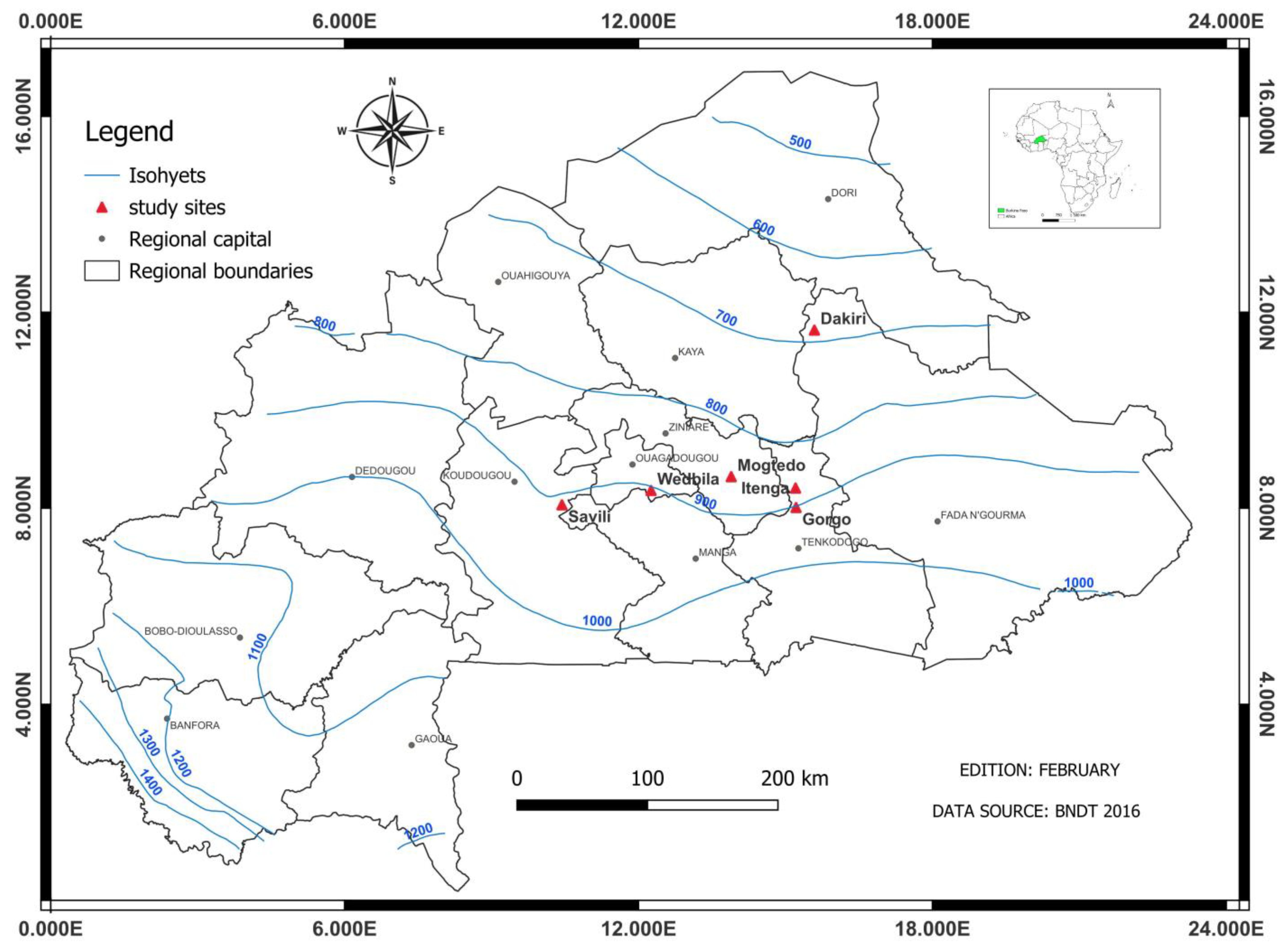
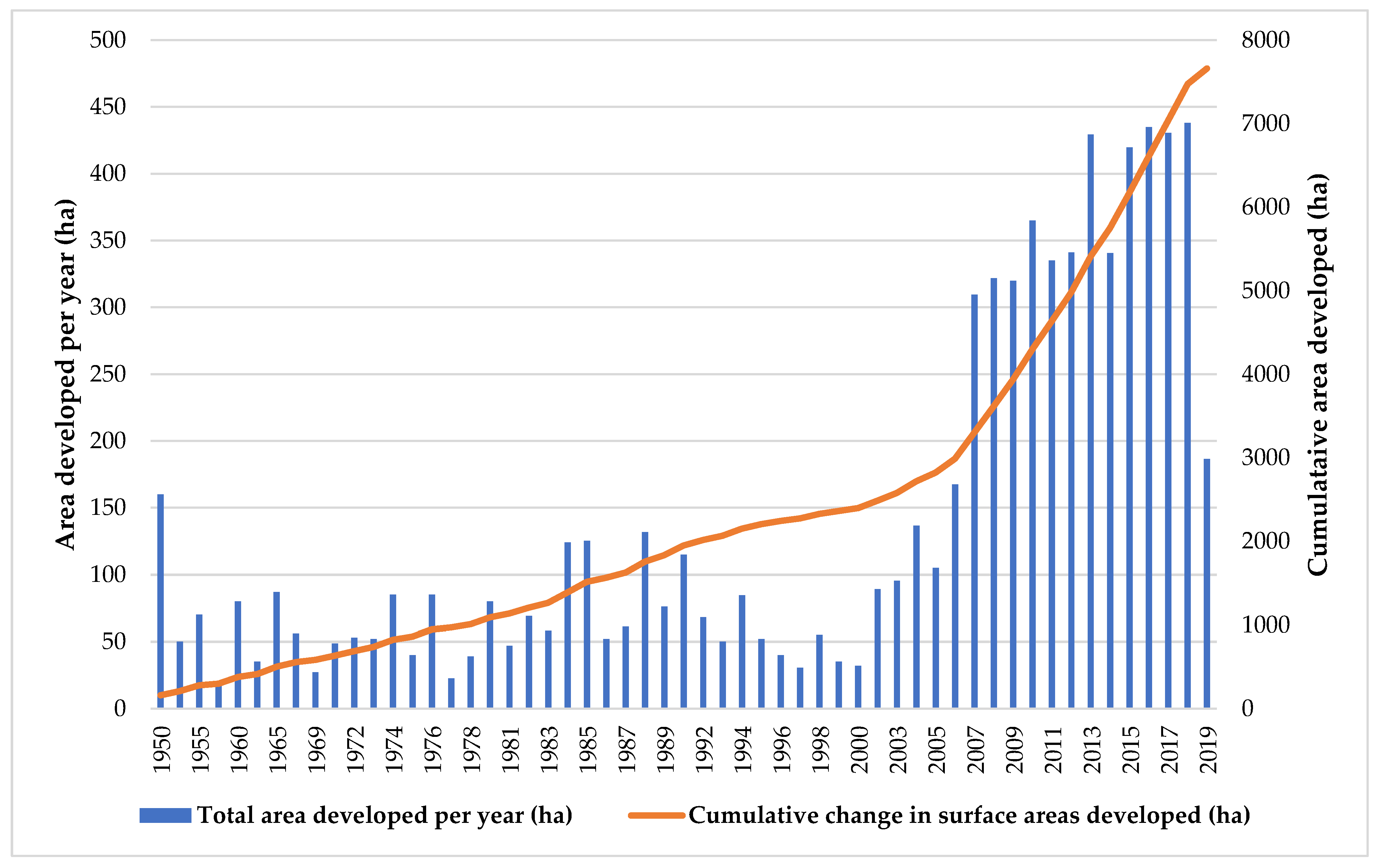
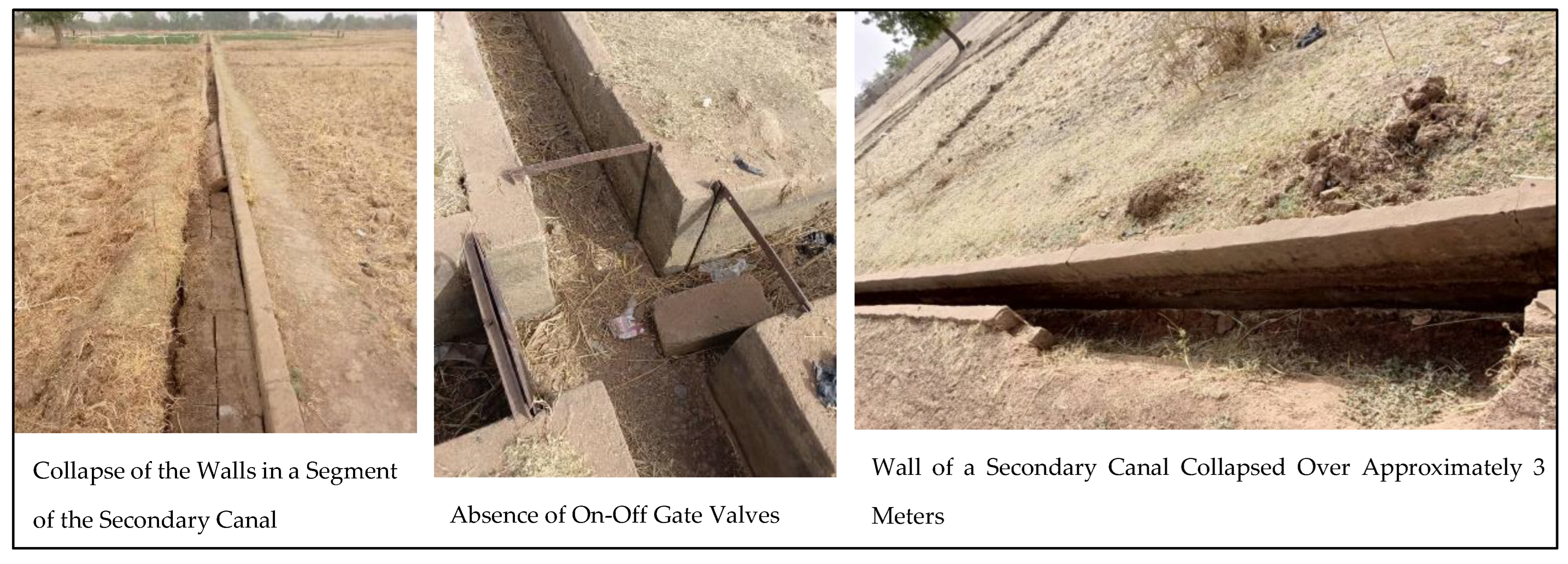

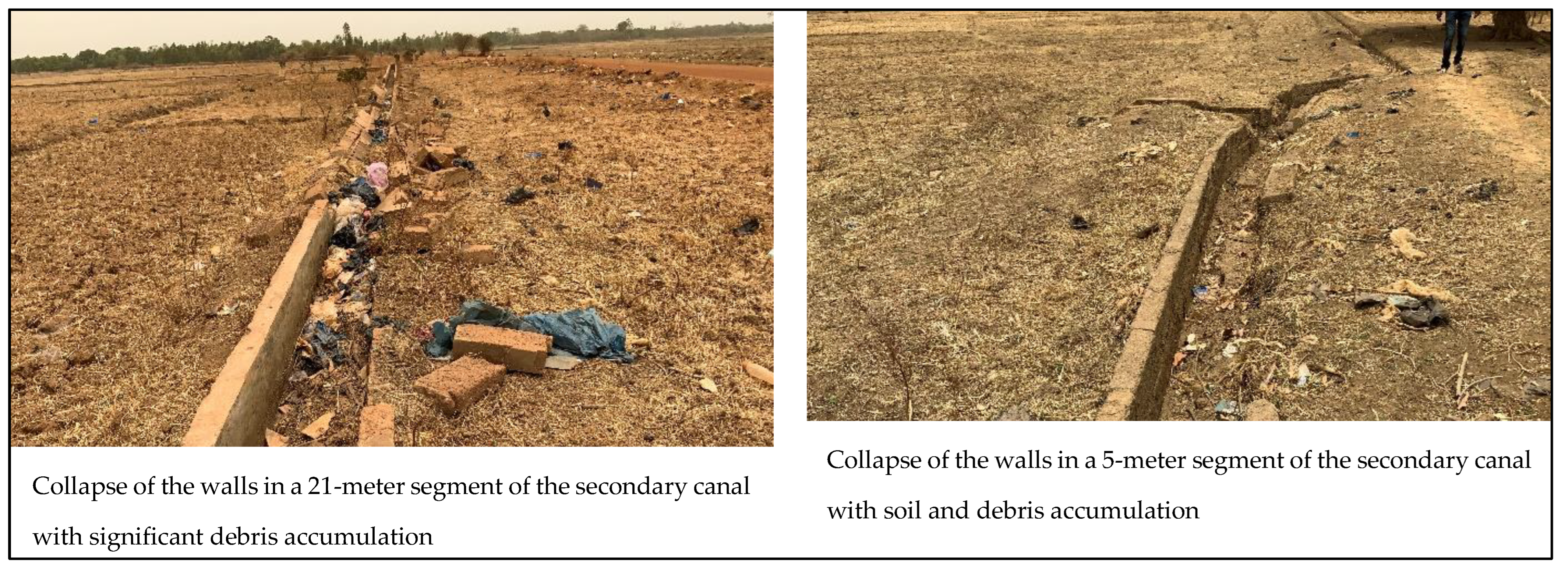
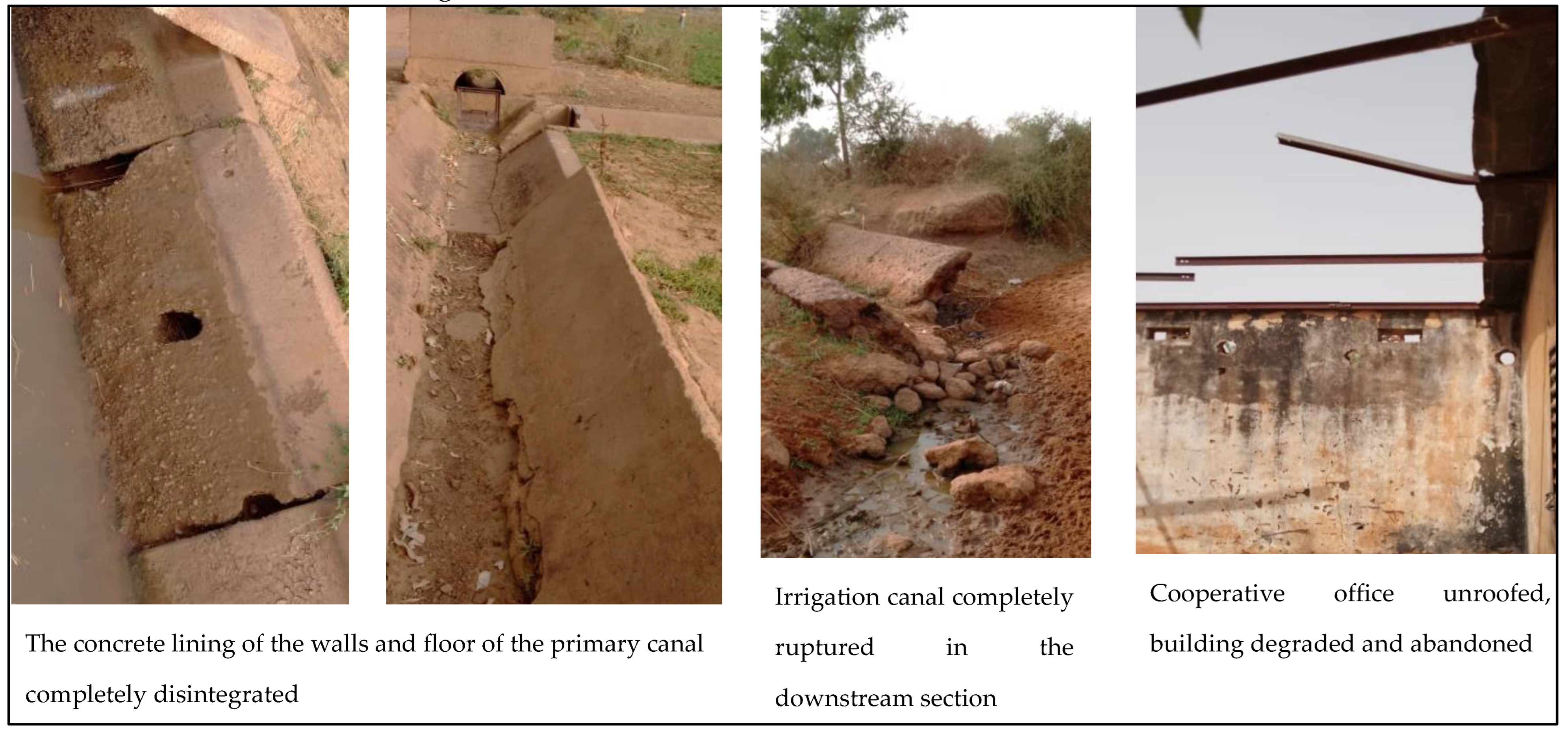
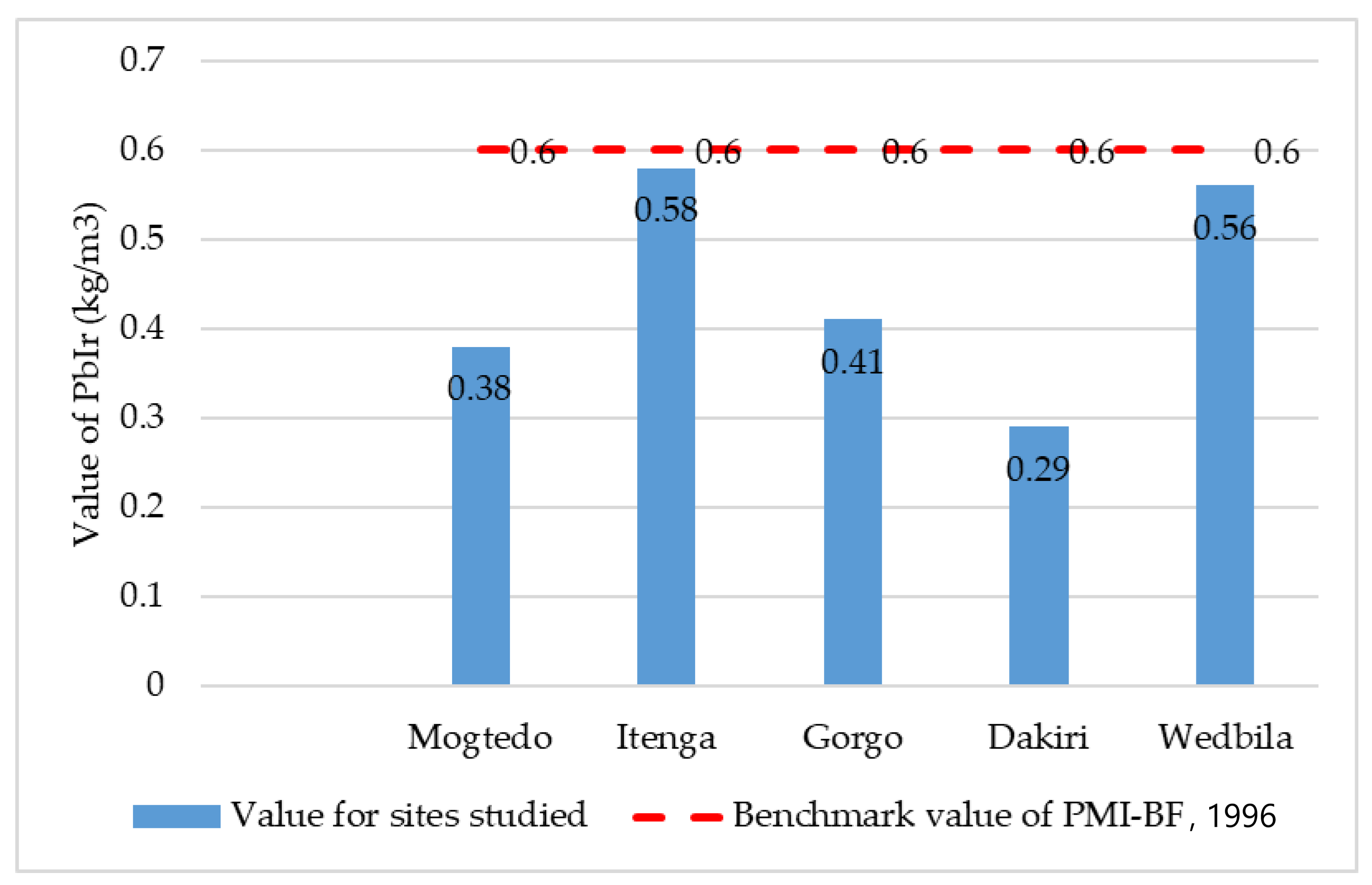
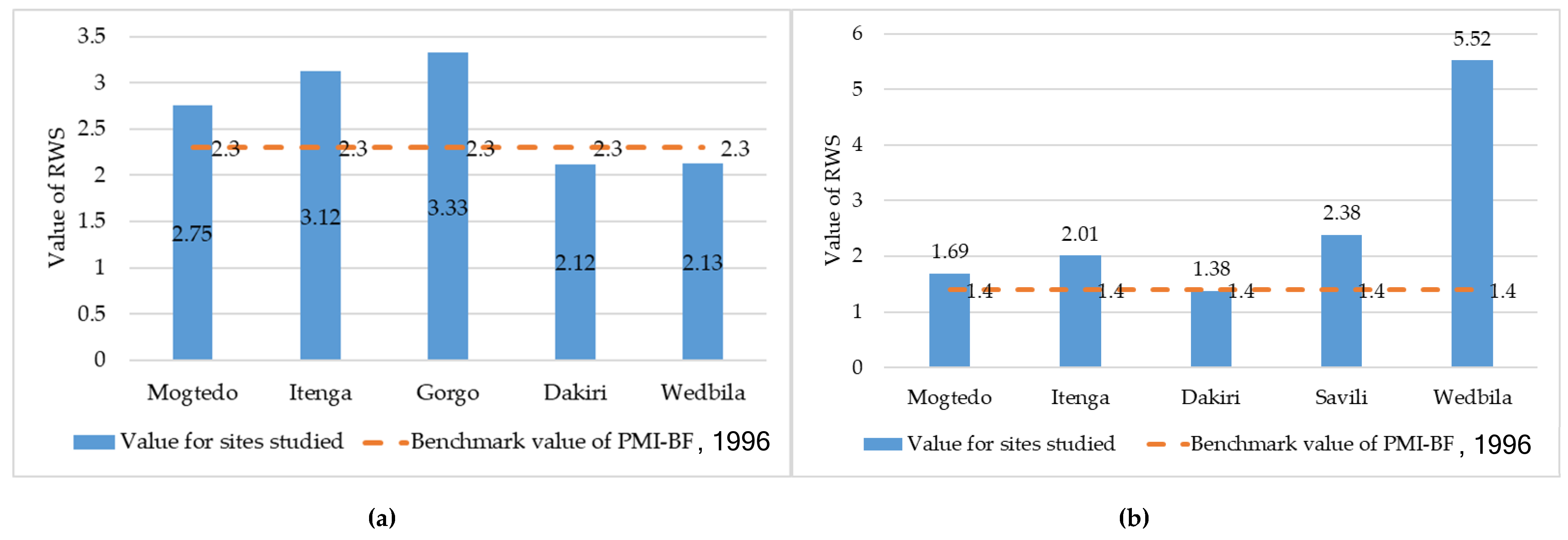
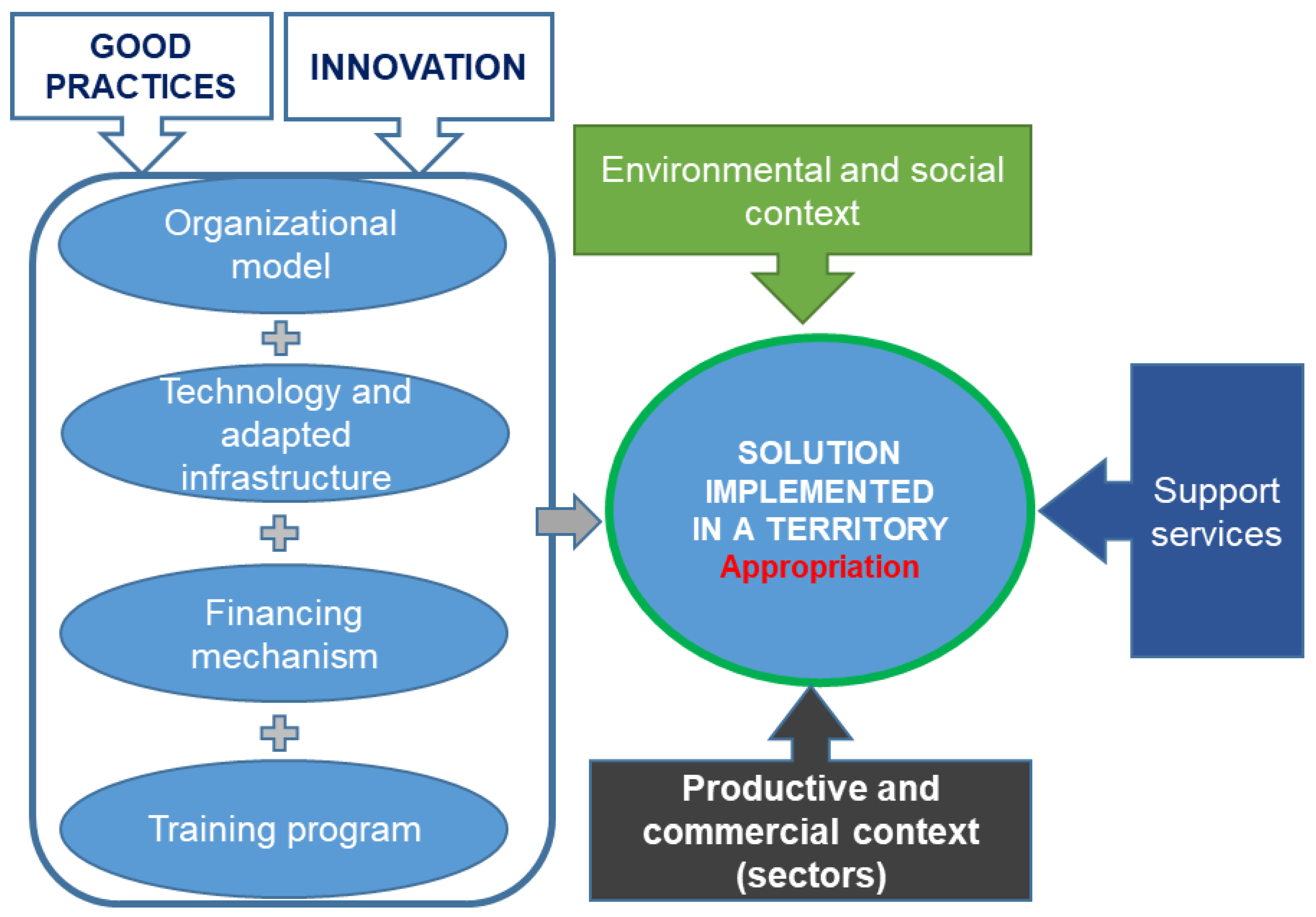
| Dakiri | Gorgo | Itenga | Mogtedo | Savili | Wedbila | ||
|---|---|---|---|---|---|---|---|
| Geographical coordinates | Latitude North | 00°16′ | 00°22′ | 00°23′ | 00°50′ | 02°02′ | 1°25′ |
| Longitude West | 13°18′ | 12°02′ | 12°11′ | 12°18′ | 12°05′ | 12°09′ | |
| The year of dam construction | 1959 | 1980 | 1987 | 1963 | 1979 | 1975 | |
| Year of development | 1984 | 1991 | 1989 | 1967 | 1984 | 1979 | |
| Gross capacity of the reservoir (m3) | 10,460,000 | 1,350,000 | 2,500,000 | 6,560,000 | 2,280,000 | 2,480,000 | |
| Irrigated perimeter (ha) | 112 | 50 | 48 | 123 | 42 | 44 | |
| Type of irrigation | gravity | gravity | gravity | gravity | mid- pressure/mid-gravity | gravity | |
| Objectives | Indicators | Expressions | |
|---|---|---|---|
| Name | Symbol (Units) | ||
| Production and productivity | Yield | Y (kg/ha) | |
| Gross production per unit of irrigation water consumed | PbIr (kg/m3) | ||
| Resource use | Relative water supply | RWS | |
| Sustainability | Water fee recovery | RR (%) | |
| Category | Indicators | Values Obtained by PMI-BF | Suggested References | Interpretation of the Indicator |
|---|---|---|---|---|
| Production and productivity | Y (kg/ha) | 5000 (paddy) | 5000 | A value below the reference value means that the perimeter is not productive; otherwise, yields on the perimeter are good. |
| PbIr (kg/m3) | 0.39 (paddy) | 0.6 (paddy) | A value higher than the reference indicates good irrigation water use on the perimeter. A value below the reference indicates either poor production (see yield) or excessive volumes of water withdrawn for irrigation (see RWS). | |
| Use of resources | RWS | 2.9 (wet season) | 2.3 (paddy) | A value close to the benchmark is a good indication of water management performance. A value well above the reference indicates water wastage and a value below indicates water scarcity. This may be because farmers find it difficult to manage irrigation and rainfall together. It may also be due to insufficient rainfall or irrigation (water loss in the network). |
| 2 (dry season) | 1.4 (dry season market gardening) | |||
| Durability | RR (%) | 88 | 100 | A value close to the benchmark suggests a reasonable collection rate. It also makes assessing compliance with the OGSI’s internal regulations possible. If RR is below the reference value, then there is a shortfall in the Irrigation System Management Organization (OGSI)’s financial resources. The reasons for this may be a lack of motivation on the part of the farmers, as a result of a level of water charges that is too high for their income, or a lack of credibility on the part of the OGSI Board. |
| Attribute | Itenga | Gorgo | Dakiri | Mogtedo |
|---|---|---|---|---|
| Irrigated Perimeter (ha) | 48 | 50 | 120 | 123 |
| Utilized Area (ha) | 48 | 50 | 170 | 123 |
| Organization Name | Namalgb-Zanga | SCOOPS Wend-Panga | USCPR-Dakiri | - |
| Type of Organization | Simplified Cooperative | Simplified Cooperative | Union of Cooperatives | Simplified Cooperative |
| Date of Establishment | 17 April 2020 | 1 May 2016 | 22 December 2022 | - |
| Last Executive Renewal Year | 2021 | 2021 | No renewal since the creation | - |
| Total Membership | 230 (192 men, 38 women) | 212 (152 men, 60 women) | 747 (644 men, 103 women) | 422 (250 men, 172 women) |
| Organizational Structure | 1. Management Council 2. Control Committee 3. Irrigators’ Committee 4. Local Facilitators | 1. Management Council | 1. Management Council 2. Control Committee 3. Irrigators’ Committee 4. COGES | 1. Management Council 2. Control Committee 3. Irrigators’ Committee |
| Irrigators’ Committee Members | 8 | 3 | 15 | - |
| Activity Program in Place | Yes | No | Yes | No |
| Action Plan in Place | Yes | No | No | No |
| Key Activities of CI | Manages water distribution (valves); Reports to Executive Board for repairs | Maintenance of infrastructure; Water management | Maintenance of infrastructure | Maintenance of infrastructure |
| Frequency of Meetings | 1. Six General Assemblies (AGO) per year; 2. Extraordinary Assemblies (AGE) as needed | General Assemblies (AGO) | 1. Two AGOs per year 2. AGE as needed | Only Extraordinary Assemblies (AGE) |
| Average Participation Rate in Assemblies | 60% | 65% | 33% | 30% |
| Management Tools Used | 1. Meeting and Assembly Minutes 2. Activity Programs 3. Asset Management Documents 4. Membership Registry 5. Bank Account Records | Activity Programs | 1. Meeting and Assembly Minutes 2. Activity Programs | Membership Registry |
| Participation in Association Activities | Good | Average | Good | Average |
| Participation in Communal Work (%) | 75 | 33 | 48 | 25 |
| Types of Sanctions Applied | Fines; Plot Withdrawal | Plot Withdrawal | Fines; Plot Withdrawal; Exclusion | Fines; Plot Withdrawal |
| Conflict Resolution Mechanisms | By Executive Board and General Assembly decision | Amicable Settlement | Amicable Settlement; Intervention of CI | By Cooperative Board Leaders |
| Condition of Irrigation Infrastructure | Poor | Poor | Poor | Poor |
| Average Rice Yield Over 5 Years (t/ha) | 4 | 4.8 | 5 | 3.5 |
| Funding Sources | Self-funding; Loans; Water fees; Profit from rice and input sales | Water fees | Equity Capital; Loans; Water fees | Water fees |
| Water Fee Recovery Rate (%) | 82 | 97 | N/A | 50 |
| Aims and Objectives | Indicators | Values of the Indicator | Reference Values | |||||
|---|---|---|---|---|---|---|---|---|
| Wedbila | Dakiri | Gorgo | Itenga | Mogtedo | Savili | PMI-BF | ||
| Production and productivity | R: Average rice paddy yield (Kg/ha) in 1996 | 3945 | 4680 | 6903 | 3725 | ≥5000 | ||
| R: Average rice paddy yield (Kg/ha) in 2023 | 4500 | 4500 | 4800 | 4500 | 3500 | |||
| Gross production per unit of irrigation water consumed (PbIr, kg/m3) for rice | 0.56 | 0.29 | 0.41 | 0.58 | 0.38 | ≥0.6 | ||
| Utilization of resources | Relative water supply (RWS) for rice during the wet season | 2.13 | 2.12 | 3.33 | 3.12 | 2.75 | ≈2.3 | |
| Relative water supply (RWS) for dry-season vegetable farming | 5.52 | 1.38 | 2.01 | 1.69 | 2.38 | ≈1.4 | ||
| Sustainability | Water fee recovery rate (RR, %) in 1996 | 92% | 85% | 96% | 75% | 96% | 100% | |
| Water fee recovery rate (RR, %) in 2023 | 4% | 97% | 85% | 50% | 100% | |||
| Challenge | Burkina Faso | International Experiences |
|---|---|---|
| Management model | Community management with limited state oversight for Type 3 irrigation schemes | Hybrid models: community participation and government support (Morocco, China, Nepal) |
| Governance and accountability | Lack of effective leadership in some associations | Stricter governance rules and penalties for non-compliance (Nepal, Peru) |
| Maintenance and sustainability of infrastructure | Rapid deterioration due to lack of funding and maintenance | Maintenance financed by public–private partnerships (Morocco, Mexico) |
| Involvement of users | Low involvement in decision-making | Greater involvement of farmers through financial and technical incentives (India, Philippines) |
| Water fee collection | Low payment rates, dependence on subsidies | Graduated charges and compulsory maintenance funds (Brazil, China) |
| Managing water resource-related conflicts | Lack of effective conflict resolution mechanisms | State intervention to arbitrate conflicts (Benin, Ghana, Tunisia) |
| Adaptation to climate change | Lack of alternative solutions in the event of drought | Drip irrigation systems and water-saving solutions (Israel, Australia) |
| Indicators | Type 3 (Community Management) | Type 4 (Karfiguela and Kou Valley, [11]) | Reference PMI-BF |
|---|---|---|---|
| Average rice yield (kg/ha, 2023) | 3500–4800 | 4200–4900 | ≥5000 |
| Gross production per unit of irrigation water (PbIr, kg/m3) | 0.29–0.58 | 0.42–0.56 | ≥0.6 |
| Relative water supply (RWS) wet season | 2.12–3.33 | 2.4–3.1 | ≈2.3 |
| Water charge collection rate (%) | 4–97% | 50–85% | 100% |
Disclaimer/Publisher’s Note: The statements, opinions and data contained in all publications are solely those of the individual author(s) and contributor(s) and not of MDPI and/or the editor(s). MDPI and/or the editor(s) disclaim responsibility for any injury to people or property resulting from any ideas, methods, instructions or products referred to in the content. |
© 2025 by the authors. Licensee MDPI, Basel, Switzerland. This article is an open access article distributed under the terms and conditions of the Creative Commons Attribution (CC BY) license (https://creativecommons.org/licenses/by/4.0/).
Share and Cite
Baki, C.B.; Keïta, A.; Palé, S.; Traoré, F.; Bambara, A.; Moyenga, A.R.; Wellens, J.; Djaby, B.; Tychon, B. Community Management of Irrigation Infrastructure in Burkina Faso: A Diagnostic Study of Six Dam-Adjacent Irrigation Areas. Agriculture 2025, 15, 477. https://doi.org/10.3390/agriculture15050477
Baki CB, Keïta A, Palé S, Traoré F, Bambara A, Moyenga AR, Wellens J, Djaby B, Tychon B. Community Management of Irrigation Infrastructure in Burkina Faso: A Diagnostic Study of Six Dam-Adjacent Irrigation Areas. Agriculture. 2025; 15(5):477. https://doi.org/10.3390/agriculture15050477
Chicago/Turabian StyleBaki, Cyrille Bassolo, Amadou Keïta, Sié Palé, Farid Traoré, Apolline Bambara, Alexandre Ragnagué Moyenga, Joost Wellens, Bakary Djaby, and Bernard Tychon. 2025. "Community Management of Irrigation Infrastructure in Burkina Faso: A Diagnostic Study of Six Dam-Adjacent Irrigation Areas" Agriculture 15, no. 5: 477. https://doi.org/10.3390/agriculture15050477
APA StyleBaki, C. B., Keïta, A., Palé, S., Traoré, F., Bambara, A., Moyenga, A. R., Wellens, J., Djaby, B., & Tychon, B. (2025). Community Management of Irrigation Infrastructure in Burkina Faso: A Diagnostic Study of Six Dam-Adjacent Irrigation Areas. Agriculture, 15(5), 477. https://doi.org/10.3390/agriculture15050477






